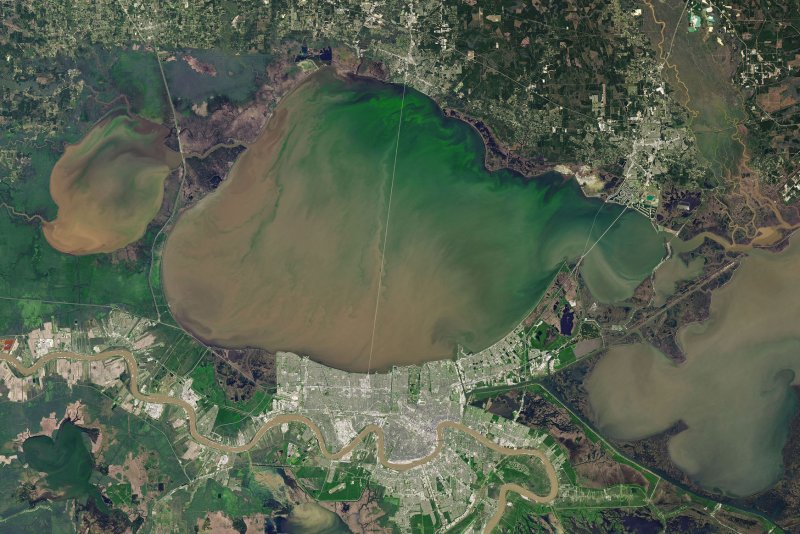Fertilizer-rich runoff can trigger algae blooms, which depletes oxygen supplies and causes ecological damage. Photo by NASA/UPI |
License Photo
Oct. 8 (UPI) -- Fertilizer can accumulate over time, causing environmental damage several decades later.
In a new study, scientists quantified the maximum amount of nutrients land can hold before fertilizers overflow into downriver ecosystems. Their analysis suggests an average square mile of land can hold 1,800 pounds of phosphorus -- 2.1 metric tons per square kilometer.
"Beyond this, further phosphorus inputs to watersheds cause a significant acceleration of phosphorus loss in runoff," researchers wrote in their paper, published this week in the journal Nature Geoscience.
Nutrients like phosphorus help plants grow, but an abundance of nutrients can accelerate plant and algae growth unnaturally, disrupting ecosystems and causing environmental damage.
For their study, scientists at the University of Montreal and McGill University focused on 23 watersheds draining into Quebec's St. Lawrence River. Researchers reconstructed the history of land use within the 23 watersheds in order to calculate phosphorus accumulation.
Some of the land within the 23 watersheds is home to pristine forest, while other plots have hosted agricultural activities for decades. Fertilizer and animal manure account for most phosphorus inputs, but sewage can also contribute.
By comparing the impacts of different plots of land -- each with unique land use histories -- on water quality, scientists were able to calculate the tipping point for when overflows begin to impact downstream ecosystems.
"Think of the land as a sponge," Roxane Maranger, an aquatic ecosystem ecologist at Montreal, said in a news release. "After a while, sponges that absorb too much water will leak. In the case of phosphorus, the landscape absorbs it year after year after year, and after a while, its retention capacity is reduced. At that point historical phosphorus inputs contribute more to what reaches our water."
The new research offers a broader perspective on the problem of agricultural runoff.
"This is a very important finding," said Elena Bennett, sustainability scientist at McGill University. "It takes our farm-scale knowledge of fertilizers and pollution and scales it up to understand how whole watersheds respond within a historical context."
Because so much land in Canada, China, the United States and elsewhere is either saturated with phosphorus or close to it, scientists say more work needs to be done to develop strategies for absorbing excess nutrients.
"Instead of adding more and more to help plants grow, phosphorus already stored in soils can be accessed using new practices and approaches," said Jean-Olivier Goyette, a doctoral student in biology at the University of Montreal. "Furthermore, phosphorus can be recycled and reused as fertilizer rather than accessing more of the raw mined material."















